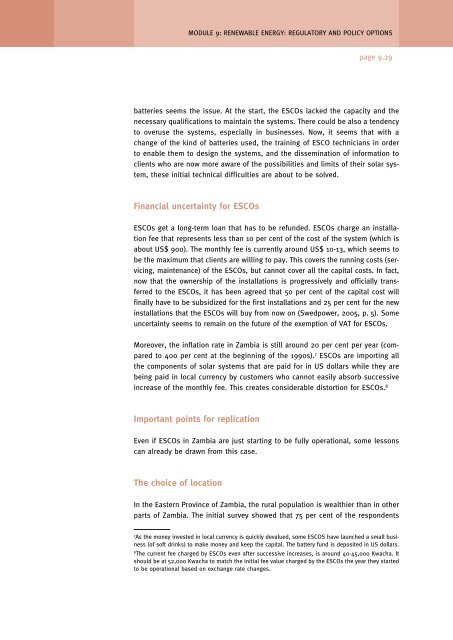Regulatory and policy options to encourage development of ...
Regulatory and policy options to encourage development of ...
Regulatory and policy options to encourage development of ...
- No tags were found...
You also want an ePaper? Increase the reach of your titles
YUMPU automatically turns print PDFs into web optimized ePapers that Google loves.
MODULE 9: RENEWABLE ENERGY: REGULATORY AND POLICY OPTIONSpage 9.29batteries seems the issue. At the start, the ESCOs lacked the capacity <strong>and</strong> thenecessary qualifications <strong>to</strong> maintain the systems. There could be also a tendency<strong>to</strong> overuse the systems, especially in businesses. Now, it seems that with achange <strong>of</strong> the kind <strong>of</strong> batteries used, the training <strong>of</strong> ESCO technicians in order<strong>to</strong> enable them <strong>to</strong> design the systems, <strong>and</strong> the dissemination <strong>of</strong> information <strong>to</strong>clients who are now more aware <strong>of</strong> the possibilities <strong>and</strong> limits <strong>of</strong> their solar system,these initial technical difficulties are about <strong>to</strong> be solved.Financial uncertainty for ESCOsESCOs get a long-term loan that has <strong>to</strong> be refunded. ESCOs charge an installationfee that represents less than 10 per cent <strong>of</strong> the cost <strong>of</strong> the system (which isabout US$ 900). The monthly fee is currently around US$ 10-13, which seems <strong>to</strong>be the maximum that clients are willing <strong>to</strong> pay. This covers the running costs (servicing,maintenance) <strong>of</strong> the ESCOs, but cannot cover all the capital costs. In fact,now that the ownership <strong>of</strong> the installations is progressively <strong>and</strong> <strong>of</strong>ficially transferred<strong>to</strong> the ESCOs, it has been agreed that 50 per cent <strong>of</strong> the capital cost willfinally have <strong>to</strong> be subsidized for the first installations <strong>and</strong> 25 per cent for the newinstallations that the ESCOs will buy from now on (Swedpower, 2005, p. 5). Someuncertainty seems <strong>to</strong> remain on the future <strong>of</strong> the exemption <strong>of</strong> VAT for ESCOs.Moreover, the inflation rate in Zambia is still around 20 per cent per year (compared<strong>to</strong> 400 per cent at the beginning <strong>of</strong> the 1990s). 7 ESCOs are importing allthe components <strong>of</strong> solar systems that are paid for in US dollars while they arebeing paid in local currency by cus<strong>to</strong>mers who cannot easily absorb successiveincrease <strong>of</strong> the monthly fee. This creates considerable dis<strong>to</strong>rtion for ESCOs. 8Important points for replicationEven if ESCOs in Zambia are just starting <strong>to</strong> be fully operational, some lessonscan already be drawn from this case.The choice <strong>of</strong> locationIn the Eastern Province <strong>of</strong> Zambia, the rural population is wealthier than in otherparts <strong>of</strong> Zambia. The initial survey showed that 75 per cent <strong>of</strong> the respondents7As the money invested in local currency is quickly devalued, some ESCOS have launched a small business(<strong>of</strong> s<strong>of</strong>t drinks) <strong>to</strong> make money <strong>and</strong> keep the capital. The battery fund is deposited in US dollars.8The current fee charged by ESCOs even after successive increases, is around 40-45,000 Kwacha. Itshould be at 52,000 Kwacha <strong>to</strong> match the initial fee value charged by the ESCOs the year they started<strong>to</strong> be operational based on exchange rate changes.










